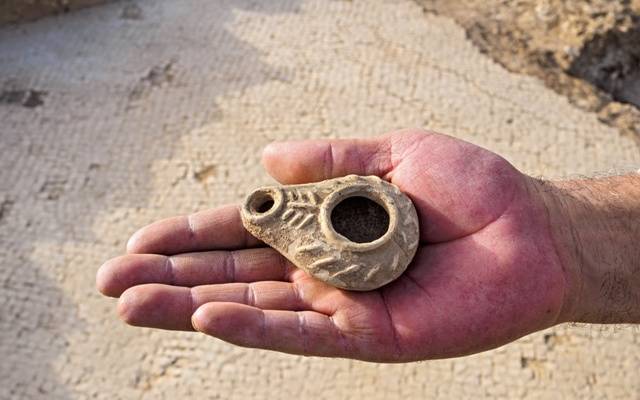Workers on a highway expansion project discovered an ancient Byzantine-era church and surrounding dwellings.

An aerial view of the site. (Skyview Company/IAA)
The upgrading and widening of the highway connecting Jerusalem to Tel Aviv has led to the discovery of a large Byzantine-era road station and church on the ancient route, the Israel Antiquities Authority (IAA) announced Wednesday.
The 1,500-year-old site lies next to a steep spring known as Ain Naqa‘a, located on the outskirts of Moshav Bet Neqofa. The church measured at about 16 meters in length and includes a side chapel that is 6.5 meters long and 3.5 meters wide with a white mosaic floor.
A baptismal font (bapisterium) in the form of a four-leafed clover symbolizing the cross was installed in the chapel’s northeast corner. Fragments of red-colored plaster found in the rubble, strewn throughout the building, indicate that the church walls had been decorated with frescoes.
To the west of the church were rooms that were probably used as dwelling quarters and for storage. One of them contained a large quantity of pottery tiles. The excavations yielded numerous finds, testifying to intensive activity at the site. These included oil lamps, coins, special glass vessels, marble fragments and mother-of-pearl shells.

The baptismal font. (Annette Nagar/IAA)
“The road station and its church were built in the Byzantine period beside the ancient road leading between Jerusalem and the coastal plain,” explained Annette Nagar, director of the IAA excavation team. “Along this road, which was apparently already established in the Roman period, other settlements and road stations have previously been discovered that served those traveling the route in ancient times.”
In February 2014, the remnants of a rural town that was lived in for some two centuries during the Second Temple period were uncovered by chance near the main route to Jerusalem under similar circumstances, when a main gas line was being installed.
“Included in the services provided along the route were churches, such as the one recently uncovered at the entrance to Abu Gosh,” Nagar continued. “Other churches have been recorded in the past in Abu Gosh, Qiryat Ye‘arim and Emmaus. This road station ceased to be used at the end of the Byzantine period, although the road beside…was renewed and continued to be in use until modern times.”
The archaeological findings are currently being studied, the IAA said, with the intent of preserving the site “for future generations.”
By: United with Israel Staff

Free Ebook: 10 Best Places to Visit in Israel
The Land of Israel has provided the backdrop for some of the most important events in human history. From the Old City in Jerusalem to the Sea of Galilee, people from all over the globe visit the Holy Land each year to take in the breathtaking scenery and inspiration of Israel. Now you can experience this beauty for yourself from the comforts of home and maybe plan a trip of your own to Israel. Get the free, exclusive eBook from United with Israel: The 10 Best Places to Visit in Israel.
